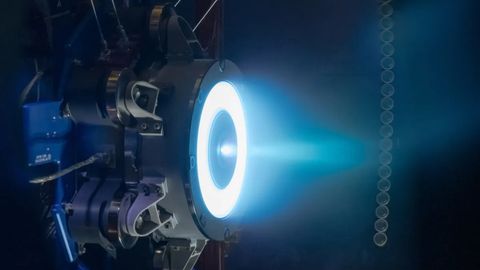China's Next Giant Leap: Building A Supercomputer In Space

Table of Contents
The Technological Challenges of a Space-Based Supercomputer
Building a supercomputer capable of operating effectively in the harsh environment of space presents unprecedented technological hurdles.
Radiation Hardening and Shielding
The intense radiation environment in space poses a significant threat to electronic components. A space-based supercomputer requires specialized hardware capable of withstanding this bombardment.
- Radiation-hardened components: These components are designed to tolerate high levels of radiation, often using specialized materials and manufacturing processes. However, creating powerful processors that are also radiation-hardened remains a significant challenge.
- Miniaturization challenges: Smaller components are generally more susceptible to radiation damage, creating a delicate balance between computing power and radiation resistance.
- Ongoing R&D: Extensive research and development are underway to create more robust and radiation-tolerant components for use in space-based systems. This includes exploring novel materials and architectures.
Thermal Management in Space
Dissipating the significant heat generated by a high-performance computer in the vacuum of space is another major challenge. The absence of convection and conduction necessitates innovative cooling solutions.
- Passive vs. active cooling: While passive cooling systems (like heat pipes) are efficient for lower power components, active cooling solutions, such as pumped fluid loops, may be necessary for high-performance computing.
- Innovative cooling technologies: Researchers are exploring advanced cooling techniques, such as loop heat pipes and miniature refrigeration systems, to manage heat effectively in the space environment.
- Material science considerations: The choice of materials is crucial for effective thermal management. Materials with high thermal conductivity and low thermal expansion are critical for efficient heat dissipation and structural integrity.
Powering a Space-Based Supercomputer
The energy requirements for a powerful space-based supercomputer are substantial. Finding a reliable and efficient power source is vital for its sustained operation.
- Solar power limitations: While solar power is a readily available source, its output varies greatly depending on the spacecraft's orbital position and solar irradiance. This variability makes it challenging for consistent performance.
- Nuclear power options: Radioisotope thermoelectric generators (RTGs) offer a more consistent power source, but they are expensive, complex, and raise safety concerns.
- Energy efficiency considerations: Maximizing energy efficiency in all components is crucial to minimize power consumption and extend operational lifespan. This necessitates advanced power management techniques and low-power components.
- Advanced Battery Technology: High-capacity, long-life batteries are needed to bridge power gaps and provide reliable backup power. This requires ongoing research in battery chemistry and design.
Potential Applications and Benefits of a Space-Based Supercomputer
The successful development of a China's space-based supercomputer would have far-reaching implications across various fields.
Advanced Earth Observation
A space-based supercomputer could dramatically improve Earth observation capabilities.
- Real-time data processing: The ability to process vast amounts of data in real-time would enable immediate responses to environmental events and disasters.
- Improved image resolution: Higher resolution imaging and faster processing would lead to more detailed and accurate environmental monitoring.
- Faster analysis of large datasets: The increased processing power could accelerate the analysis of large datasets from various sensors, improving climate modeling and resource management.
Deep Space Exploration and Communication
The enhanced computing power would revolutionize deep space exploration.
- Autonomous spacecraft operation: A space-based supercomputer could enable more autonomous operation of spacecraft, reducing the reliance on ground control and increasing mission efficiency.
- Real-time data analysis from distant probes: Data from distant probes could be processed in real-time, allowing for immediate adjustments to mission parameters and faster scientific discoveries.
- Enhanced communication capabilities: Advanced data compression and processing techniques could enable more efficient communication with spacecraft across vast interstellar distances.
Scientific Research and Discovery
A space-based supercomputer would accelerate scientific breakthroughs in various fields.
- Processing astronomical data: The computer could handle massive datasets from astronomical surveys, enabling faster identification of celestial objects and patterns.
- Simulations of complex astrophysical phenomena: More complex and detailed simulations of black holes, galaxy formation, and other astrophysical phenomena would be possible.
- Faster data analysis leading to quicker discoveries: The increased processing speed would dramatically reduce the time required for data analysis, potentially accelerating the pace of scientific discoveries.
China's Progress and Future Plans for Space-Based Supercomputing
While specifics are limited due to the sensitivity of the project, some information regarding China's progress is available.
Current Research and Development
China's leading universities and research institutions are likely heavily involved in the research and development of key technologies required for a space-based supercomputer. Significant government funding supports these efforts.
- Collaboration with universities and research institutions: China's robust research infrastructure suggests extensive collaboration between governmental agencies, universities, and private research entities.
- Government funding: The Chinese government's commitment to space exploration ensures substantial financial backing for this ambitious project.
- Technological breakthroughs: Reports suggest ongoing progress in areas like radiation-hardened electronics and advanced cooling technologies.
Timeline and Projected Launch
A precise timeline for a Chinese space-based supercomputer remains undisclosed. However, given China's ambitious space program, a launch within the next decade or two is plausible.
- Stages of development: The project likely involves multiple phases, from component development to testing and integration.
- Potential launch dates: Specific launch dates are not publicly available but could be announced as development progresses.
- Ambitious goals: China's consistent achievement of ambitious space goals indicates a serious commitment to this project's success.
International Collaboration and Competition
While the details of international collaborations remain unclear, the implications of a Chinese-led space-based supercomputer are significant.
- Collaboration opportunities: Future international collaborations are possible, leading to shared advancements and scientific discoveries.
- Potential geopolitical implications: The development and deployment of this technology will undoubtedly have geopolitical implications, influencing the global space race.
- Technological rivalry: The development of a space-based supercomputer will intensify the technological competition among major spacefaring nations.
Conclusion
Building a space-based supercomputer presents immense technological challenges, requiring breakthroughs in radiation hardening, thermal management, and power generation. However, the potential benefits are equally significant, promising advancements in Earth observation, deep space exploration, and scientific discovery. China's ambitious pursuit of this goal highlights its commitment to technological leadership in space. Stay informed about the progress of China's space-based supercomputer and its impact on the future of space exploration and scientific discovery. Follow the advancements in China's ambitious quest to build a revolutionary space-based supercomputer, a true giant leap for both space and computing technology.

Featured Posts
-
 Real Madrid Manager Search Klopps Agent Speaks Out
May 21, 2025
Real Madrid Manager Search Klopps Agent Speaks Out
May 21, 2025 -
 Germanys Determined Bid For Victory Against Italy
May 21, 2025
Germanys Determined Bid For Victory Against Italy
May 21, 2025 -
 Drier Weather Ahead Your Guide To Seasonal Adjustments
May 21, 2025
Drier Weather Ahead Your Guide To Seasonal Adjustments
May 21, 2025 -
 Manazerske Preferencie Home Office Vs Kancelaria Vyskum A Statistiky
May 21, 2025
Manazerske Preferencie Home Office Vs Kancelaria Vyskum A Statistiky
May 21, 2025 -
 Family Struck By Train Two Dead Childrens Fate Uncertain
May 21, 2025
Family Struck By Train Two Dead Childrens Fate Uncertain
May 21, 2025
Latest Posts
-
 Preparing For High Winds Associated With Fast Moving Storms
May 21, 2025
Preparing For High Winds Associated With Fast Moving Storms
May 21, 2025 -
 Bundesliga Leverkusens Upset Delays Bayerns Title Festivities Kane Sidelined
May 21, 2025
Bundesliga Leverkusens Upset Delays Bayerns Title Festivities Kane Sidelined
May 21, 2025 -
 Bangladeshinfo Com Your Comprehensive Guide To Bangladesh
May 21, 2025
Bangladeshinfo Com Your Comprehensive Guide To Bangladesh
May 21, 2025 -
 Cultivating Resilience A Guide To Mental Strength
May 21, 2025
Cultivating Resilience A Guide To Mental Strength
May 21, 2025 -
 Staying Safe During Fast Moving Storms With High Winds
May 21, 2025
Staying Safe During Fast Moving Storms With High Winds
May 21, 2025
